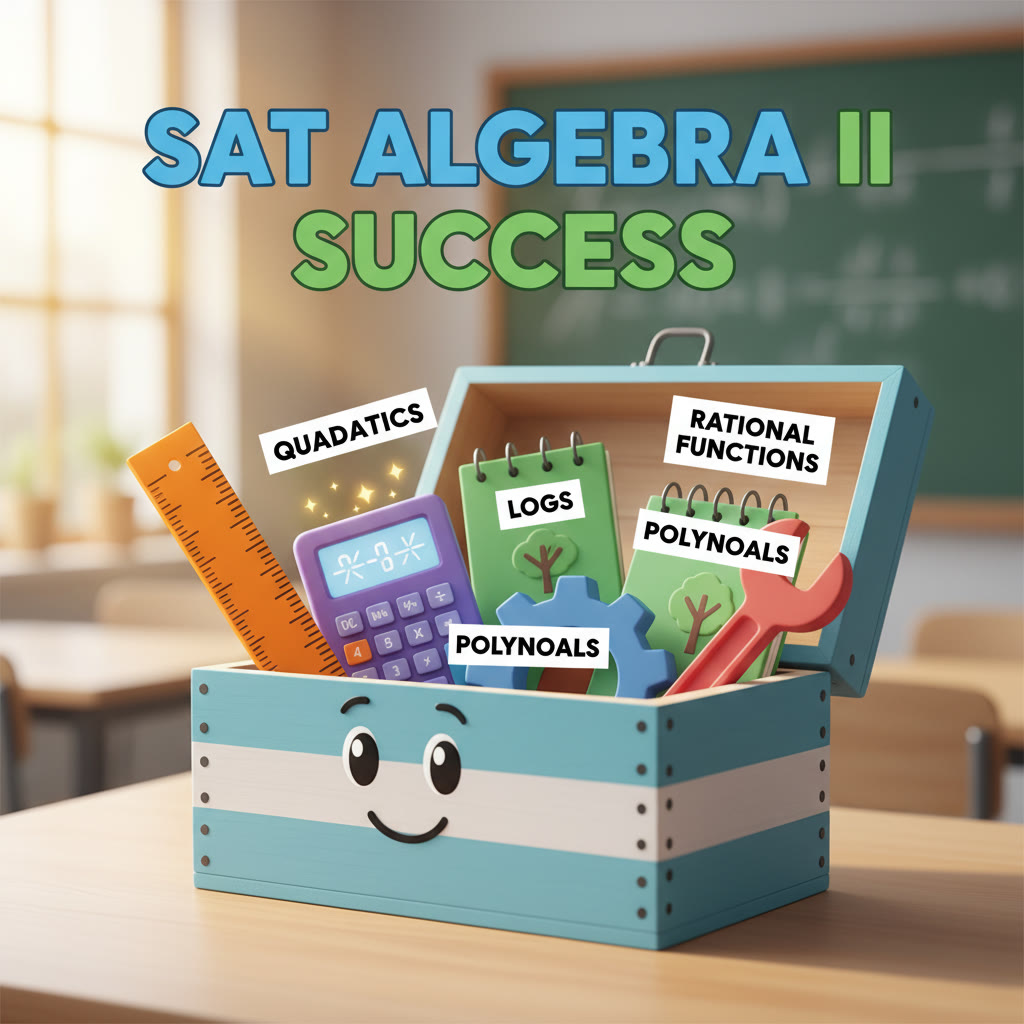Why Algebra II matters on the SAT
If the SAT were a conversation, Algebra II would be one of the most popular topics. It shows up across question types, rewards pattern recognition, and separates steady problem-solvers from rushed guessers. Unlike isolated arithmetic questions, Algebra II problems connect functions, roots, growth patterns, and manipulations — it’s a test of fluency more than novelty.
Think of Algebra II on the SAT as a toolbox. The test rarely expects you to invent new tools; it expects you to pick the right one, use it correctly, and explain the result in a clear, often compact way. That’s good news: with targeted practice you can build predictable strategies and avoid the scrambling that costs points.

Core Algebra II topics tested
Below are the Algebra II areas you should treat as essentials, with quick notes on how they typically show up on the SAT.
Quadratic functions and equations
Quadratics are everywhere: solving by factoring, completing the square, using the quadratic formula, analyzing vertex and axis of symmetry, and interpreting parabolas on graphs. SAT questions often ask for roots, vertex coordinates, or comparisons like which of two parabolas opens wider.
Tip: memorize the quadratic formula and practice completing the square. Often the fastest route on test day is to use structure — like converting to vertex form to read off maximum or minimum values directly.
Polynomials and factoring
Questions can involve addition, subtraction, multiplication, division of polynomials, and factoring to reveal zeros. Synthetic division and the Remainder Theorem appear implicitly in multiple-choice settings where you check roots quickly.
Tip: when you see polynomial expressions, look first for a factorable pattern. Factoring often turns a complicated expression into a short calculation.
Rational expressions and equations
These show up as simplification tasks, solving rational equations, or analyzing asymptotic behavior in graphs. The SAT prefers clean domains: it’s common to be asked about excluded values or transformations that affect vertical and horizontal asymptotes.
Exponential and logarithmic relationships
Exponential growth and decay and their logarithmic inverses are classic Algebra II material. SAT items often ask you to translate between forms, solve simple exponential equations, or understand how changing a base affects growth rate.
Systems of equations (linear and nonlinear)
Two-variable systems are frequent. The SAT favors strategic elimination, substitution, and occasionally clever observation like adding two equations to cancel a variable. Nonlinear systems — involving a line and a parabola, for example — test intersection reasoning and counting solutions.
Functions, transformations, and compositions
Understanding function notation, domain and range, shifts, stretches, reflections, and compositions is essential. The test may ask you to track how a transformation changes a graph or to evaluate composite functions at specific inputs.
Complex numbers and sequences
Complex numbers can appear in root-related questions, and basic sequence reasoning (arithmetic and geometric) shows up in word problems. You rarely need heavy theory — more often you need to manipulate symbols correctly under exam pressure.
Typical SAT question types and the Algebra II approach
The SAT loves tidy question types. Recognizing the pattern quickly saves time. Below is a short list of familiar formats and how to tackle them.
- Direct computation. Reduce expressions smartly; cancel before multiplying when possible.
- Graph interpretation. Translate equations into graph features: intercepts, vertex, asymptotes.
- Equation solving. Check for extraneous solutions when denominators or squares are involved.
- Function manipulation. Plug in inputs or use inverse relationships rather than symbol-chasing when allowed.
- Modeling. Translate words to equations, identify which Algebra II tool fits (exponential, quadratic, or linear), and solve.
Example: translating a graph back to an equation
Imagine a parabola with vertex at (2, -3) opening upward and crossing the y-axis at 1. A quick strategy is to write vertex form y = a(x – h)^2 + k, plug in the vertex, then use the y-intercept to solve for a. That saves time compared to expanding and solving for coefficients from scratch.
Worked problems with explanations
Practice problems are where concepts turn into instincts. Try these representative items and the suggested approaches.
Problem 1: Quadratic with a twist
Solve for x: x^2 – 6x + 5 = 0
Approach: Factor quickly. The expression factors as (x – 1)(x – 5) = 0, so x = 1 or x = 5. If factoring is not obvious, the quadratic formula yields the same result, but factoring is faster on the SAT.
Problem 2: Exponential growth
A bacteria population doubles every 3 hours. Starting with 200 cells, how many after 9 hours? Write the exponential form: P(t) = 200 * 2^(t/3). For t = 9, exponent is 3, so P(9) = 200 * 2^3 = 200 * 8 = 1600.
Problem 3: System of a line and a parabola
Find intersection points of y = x^2 and y = 2x + 3. Set equal: x^2 = 2x + 3 → x^2 – 2x – 3 = 0. Factor: (x – 3)(x + 1) = 0, so x = 3 or x = -1. Corresponding y-values: y = 9 and y = 1. Two intersection points: (3,9) and (-1,1).
Problem 4: Rational equation with excluded values
Solve for x: (x + 2)/(x – 1) = 3. Multiply both sides by (x – 1): x + 2 = 3x – 3. Rearranged: -2x = -5, so x = 5/2. Check excluded value x ≠ 1; 5/2 is fine.
Quick reference table: key Algebra II forms and SAT takeaways
| Topic | Common SAT tasks | Shortcut or mindset |
|---|---|---|
| Quadratic functions | Find roots, vertex, max/min, axis of symmetry | Use vertex form for graph info; factor when possible |
| Polynomials | Factor, synthetic division, end behavior | Look for rational roots and common patterns |
| Rational expressions | Domain, asymptotes, solve equations | Cancel factors early; watch for excluded values |
| Exponential/log | Solve growth/decay, convert forms | Translate words to base and exponent carefully |
| Functions | Composition, inverse, transformations | Plug numbers to test; sketch quick graphs |
Common pitfalls and how to avoid them
- Rushing algebra manipulations. Slow down for the first line of work; an early algebra mistake becomes a permanent error.
- Ignoring domain restrictions. Especially with rational and radical equations, check that solutions don’t violate original restrictions.
- Overcomplicating simple graphs. A sketch often clarifies intersections and transformations quickly.
- Forgetting units in modeling questions. If a problem asks for hours or years, be consistent with exponential bases and time units.
- Not using answer choices. On multiple-choice items, plug answer choices back in when direct solving looks messy.
How to practice Algebra II effectively for the SAT
Practice without strategy is just repetition. An efficient plan has a few consistent elements: targeted practice, timed drills, review of mistakes, and periodic full-length practice tests to build stamina. Here’s a compact weekly approach for 8 weeks before the test.
8-week focused schedule (example)
- Weeks 1-2: Review quadratics and polynomials. Daily mini-sessions: 30 minutes of concept review, 30 minutes of practice problems.
- Weeks 3-4: Rational expressions, exponents, and logarithms. Include timed problem sets to simulate SAT pace.
- Weeks 5-6: Functions, systems, and complex numbers. Work on graph interpretation and composition problems.
- Weeks 7-8: Mixed practice, full sections under timed conditions, and focused review of errors.
Sample timed drill format (40 minutes)
- 10 minutes: Warm-up with 5 quick algebra questions (no calculator when possible).
- 20 minutes: Two medium-difficulty Algebra II SAT problems, solved fully with working shown.
- 10 minutes: Review and correct mistakes, noting any recurring error.
Using tools and resources wisely
The calculator can be helpful but rarely necessary for core Algebra II reasoning on the SAT. Use it when precise arithmetic or plotting speeds things up, but avoid relying on it for conceptual understanding. A strong strategy is to attempt a quick mental or pencil-and-paper route first, then use the calculator to check arithmetic or test answer choices.
For personalized guidance, one-on-one help can accelerate progress. Sparkl’s personalized tutoring offers tailored study plans and expert tutors who translate a student’s specific mistakes into a focused practice routine. Sparkl’s 1-on-1 guidance and AI-driven insights can highlight weak spots faster than guessing which topics to review.
Sample plan for a single Algebra II practice session
Use this 60-minute template to make sessions efficient and consistent.
- 0-10 minutes: Warm-up with quick factoring or simplification problems.
- 10-30 minutes: Focus on one topic (e.g., logs). Work through 6–8 SAT-style problems, mixing difficulty.
- 30-45 minutes: Timed mixed drill with calculator allowed if needed.
- 45-60 minutes: Review wrong answers, write down the specific error, and create a micro-plan to fix it next session.
When and how to use tutoring efficiently
Tutoring is particularly effective when it supplements disciplined self-study. Choose sessions that target weak spots rather than generic review. A good tutor helps you build shortcuts that work in testing conditions, like spotting factorable quadratics and deciding when substitution beats elimination in systems.
Sparkl’s personalized approach blends expert tutors with tailored study plans and AI-driven insights that surface patterns in your mistakes. If you find you’re consistently losing points on transformation-of-functions questions or misreading domain issues, a few focused Sparkl 1-on-1 sessions can produce outsized improvements.
Final tips before test day
- Review formulas but don’t memorize blindly. Know how and when to use the quadratic formula, compound interest forms, and basic log rules.
- Practice under timed conditions. Speed matters as much as accuracy on the SAT.
- Read every question twice. The SAT sometimes hides a twist in a short phrase that changes the whole approach.
- Use answer choices as tools. Plugging in choices or numbers can be faster than solving algebraically, especially in multiple-choice format.
- Keep a small error log. Track common mistakes and revisit them weekly until they’re gone.
Closing thoughts: turning knowledge into confidence
Algebra II on the SAT rewards clarity and practice. It doesn’t demand original math discoveries; it asks that you recognize structure, make efficient moves, and check your work. The more patterns you internalize — how quadratics behave, how rational functions signal excluded values, how logs invert exponentials — the less intimidating the math will feel.
Whether you’re self-studying or working with a tutor, the path is the same: target weak spots, practice with purpose, and simulate test conditions. When you need extra acceleration, Sparkl’s personalized tutoring can provide tailored study plans, expert tutors, and AI-driven insights to make your practice smarter, not just harder. That one-on-one guidance often turns steady effort into measurable score gains.
One last practical exercise
Before you finish reading this guide, pick one Algebra II topic you find uncomfortable. Set a 30-minute timer and do the following: 10 minutes of quick review notes, 15 minutes of targeted problems, and 5 minutes writing one sentence about the common error you made and how you will fix it. Small, intentional cycles like this compound fast.

You’ve now got a compact map of Algebra II on the SAT: what to expect, how to practice, and how to turn mistakes into improvements. Keep the tools handy, practice regularly, and approach each problem with the mindset of a detective: what structure is hiding here and which algebraic tool solves it most directly? That mindset, combined with steady practice and smart support when needed, will make Algebra II not just manageable but a strength on test day.












No Comments
Leave a comment Cancel